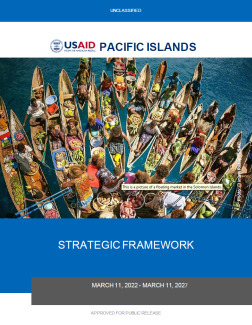The overall goal of the 2022–2027 Strategic Framework for the Pacific Islands is to advance a more democratic, prosperous, and resilient Pacific Island region. Resilience, the ability of the Pacific Islands to sustainably adapt to and recover from various natural and man-made shocks and stresses, is the guiding principle of this Framework. USAID envisions a more resilient region that can better respond and adapt to climate and disaster impacts, pandemics, and economic shocks, with strong political systems that champion democratic values, good governance, human rights, and promote equity and inclusion for all Pacific Islanders. USAID will partner with key Pacific-led regional organizations, Pacific governments, civil society, and the private sector to strengthen overall resilience and accelerate partnering to achieve the region’s vision in the 2050 Strategy for the Blue Pacific Continent. To achieve this goal, USAID will work through three Development Objectives (DOs):
DO 1: Community Resilience Strengthened
DO 2: Resilient Economic Growth Advanced
DO 3: Democratic Governance Strengthened
USAID programs assist 12 Pacific Island countries: Federated States of Micronesia, Fiji, Kiribati, Nauru, Palau, Papua New Guinea, Republic of the Marshall Islands, Samoa, Solomon Islands, Tonga, Tuvalu, and Vanuatu. These countries occupy a vast area of the Pacific Ocean that is geographically and uniquely situated to help ensure vibrant trade and security for the Americas and Asia. In 2020, the U.S. conducted over $1.75 trillion in two-way trade with the Indo-Pacific region, supporting more than 5 million jobs in the Indo-Pacific.
Ensuring freedom of commercial navigation for all is thus an international defense imperative and priority. The U.S. is deeply committed to partnering with Pacific Island countries to address their common and unique challenges to ensure their resilience and prosperity. The U.S. government has reaffirmed its commitment toward the Pacific Island countries as evidenced by visits from high-level officials to the region and additional investments as part of the first-ever U.S.-Pacific Partnership Strategy. To support the United States government’s new era of partnership in the Pacific, this Framework outlines how USAID will expand its portfolio and broaden PIC partnerships to address the region’s most pressing challenges: high vulnerability to climate change, natural disasters, health threats, and economic shocks, as well as prioritizing development partnerships and collaboration to mitigate influences that challenge the region’s stability and democratic systems. These challenges and opportunities are also consistent with the priorities articulated in the National Security Strategy.

